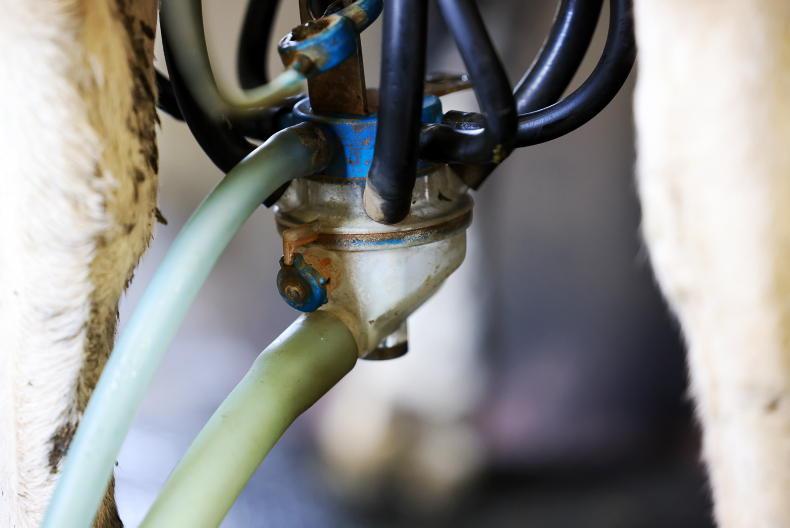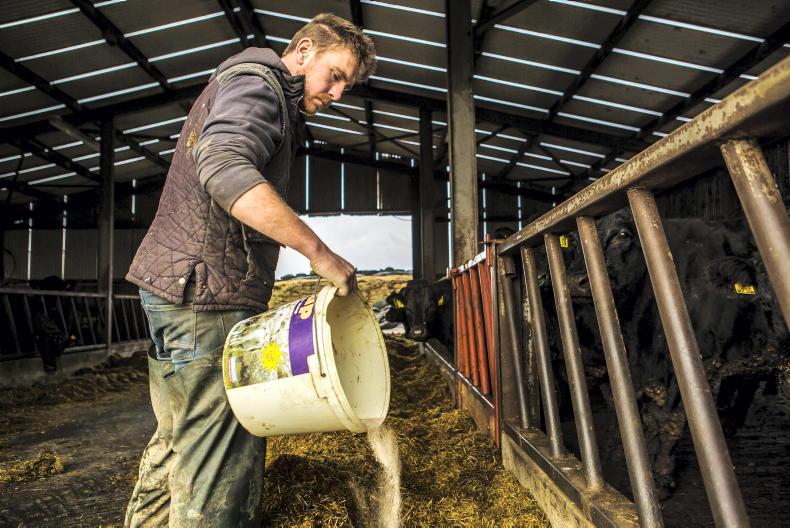A combination of improved milk price, increased milk output and a steady cost base allowed Charles Clarke’s farm business near Bailieborough, Co Cavan, to deliver a sound financial performance in 2017.
Milk price was a significant factor that led to an increase in profitability last year, with average price for 2017 up by over 10c/l year on year to 36.4c/l. An increase in cow numbers and a 5.6% increase in yield per cow meant total milk volume produced (including milk fed to calves) was up by 12.4% in 2017.
Charles’s 117 spring-calving cows yielded 5,256 litres/cow at 4.13% butterfat and 3.39% protein last season. This represents a 0.08 percentage point increase in both butterfat and protein from 2016 levels, which helped boost milk solids produced to 407kg/cow. Overall milk solids sold off the farm last year were up by 20.9% year on year to 46,467kg; this excludes milk fed to calves.
On the cost side, farm working expenses increased overall, but reduced on a per-litre basis by 0.74c/l on the back of fixed costs being spread across a higher milk volume.
Cost of production on Charles’s farm, excluding drawings, loan repayments and capital investments from cashflow, stood at 25.15c/l in 2017.
Concentrate costs increased last year as meal fed per cow rose by 42% to 869kg/cow. The extra 259kg of concentrates per cow was mainly fed during the late summer and autumn to keep yields up amid difficult grazing conditions.
All concentrates are fed through the parlour and the 103.5t fed on Charles’s farm last year equates to a feed rate of 0.15kg/litre.

Grass
Grass growth stood at 12.8t DM/ha on the Clarke farm last year and fodder supply was not an issue this winter, so no additional silage had to be purchased.
Charles’s dairy farm is a one-person operation most of the time, so the labour costs outlined are for casual labour employed at calving time and when Charles takes time off. Contractors are used on the farm for silage and slurry work.
There was limited capital expenditure on Charles’s farm last year, with €13,700 spent on farm equipment, drainage work and hardcore to resurface an area in the farmyard.
Five acres were reseeded in 2017 and costs associated with this are included in farm working expenses.
Gross output from milk and stock sales but excluding CAP payments was €262,162. With working expenses totalling €150,921 and drawings of €35,000 assumed for all Dairylink Ireland participants, there was €76,241 available on Charles’s farm last year for loan repayments, taxation, capital expenditure and additional personal drawings.

What’s next for
Charles Clarke?
There are 140 cows and heifers due to calve down here this spring, but I plan to only milk 120 cows on the farm this year. The milking platform will be stocked at over 3.5CE/ha with 120 cows and I don’t want to push stocking rate any higher.
There will be 20 surplus cows sold off shortly after they calve this spring. There is room for improvement within the herd in terms of better production of solids. I will still focus on health and fertility traits too and the overall objective is to develop a low-maintenance herd.
Current herd EBI is €73, but this should rise quickly over the next few years. The 42 replacement heifers coming into the herd this year have an average EBI of €141 and the younger calves due to be bred in May have an average EBI of €146.
Going forward, I will continue to select sires to maximise solids produced per hectare on the grazing block. Jersey genetics that were introduced into the herd will help with this and will deliver health characteristics, while at the same time reducing the average cow weight within the herd. The target weight is 500kg/cow, with 25% Jersey genetics.
Calving 2018
Calving started on 9 February and there are 60 cows and heifers calved so far. Between 75 to 80 cows and heifers are expected to calve down in the first three weeks and calving should be finished within 10 weeks.
The first cows went to grass at the weekend in an on/off grazing system.
I am targeting the driest paddocks first and cows come back in after a few hours and are fed good-quality silage (DMD over 70%) at night.
Ground conditions need to improve to get the herd back on target in terms of grazing.
Read more
Preparing for a busy spring in Cavan
Watch: growing and utilising more grass
Full coverage: Dairylink Ireland
A combination of improved milk price, increased milk output and a steady cost base allowed Charles Clarke’s farm business near Bailieborough, Co Cavan, to deliver a sound financial performance in 2017.
Milk price was a significant factor that led to an increase in profitability last year, with average price for 2017 up by over 10c/l year on year to 36.4c/l. An increase in cow numbers and a 5.6% increase in yield per cow meant total milk volume produced (including milk fed to calves) was up by 12.4% in 2017.
Charles’s 117 spring-calving cows yielded 5,256 litres/cow at 4.13% butterfat and 3.39% protein last season. This represents a 0.08 percentage point increase in both butterfat and protein from 2016 levels, which helped boost milk solids produced to 407kg/cow. Overall milk solids sold off the farm last year were up by 20.9% year on year to 46,467kg; this excludes milk fed to calves.
On the cost side, farm working expenses increased overall, but reduced on a per-litre basis by 0.74c/l on the back of fixed costs being spread across a higher milk volume.
Cost of production on Charles’s farm, excluding drawings, loan repayments and capital investments from cashflow, stood at 25.15c/l in 2017.
Concentrate costs increased last year as meal fed per cow rose by 42% to 869kg/cow. The extra 259kg of concentrates per cow was mainly fed during the late summer and autumn to keep yields up amid difficult grazing conditions.
All concentrates are fed through the parlour and the 103.5t fed on Charles’s farm last year equates to a feed rate of 0.15kg/litre.

Grass
Grass growth stood at 12.8t DM/ha on the Clarke farm last year and fodder supply was not an issue this winter, so no additional silage had to be purchased.
Charles’s dairy farm is a one-person operation most of the time, so the labour costs outlined are for casual labour employed at calving time and when Charles takes time off. Contractors are used on the farm for silage and slurry work.
There was limited capital expenditure on Charles’s farm last year, with €13,700 spent on farm equipment, drainage work and hardcore to resurface an area in the farmyard.
Five acres were reseeded in 2017 and costs associated with this are included in farm working expenses.
Gross output from milk and stock sales but excluding CAP payments was €262,162. With working expenses totalling €150,921 and drawings of €35,000 assumed for all Dairylink Ireland participants, there was €76,241 available on Charles’s farm last year for loan repayments, taxation, capital expenditure and additional personal drawings.

What’s next for
Charles Clarke?
There are 140 cows and heifers due to calve down here this spring, but I plan to only milk 120 cows on the farm this year. The milking platform will be stocked at over 3.5CE/ha with 120 cows and I don’t want to push stocking rate any higher.
There will be 20 surplus cows sold off shortly after they calve this spring. There is room for improvement within the herd in terms of better production of solids. I will still focus on health and fertility traits too and the overall objective is to develop a low-maintenance herd.
Current herd EBI is €73, but this should rise quickly over the next few years. The 42 replacement heifers coming into the herd this year have an average EBI of €141 and the younger calves due to be bred in May have an average EBI of €146.
Going forward, I will continue to select sires to maximise solids produced per hectare on the grazing block. Jersey genetics that were introduced into the herd will help with this and will deliver health characteristics, while at the same time reducing the average cow weight within the herd. The target weight is 500kg/cow, with 25% Jersey genetics.
Calving 2018
Calving started on 9 February and there are 60 cows and heifers calved so far. Between 75 to 80 cows and heifers are expected to calve down in the first three weeks and calving should be finished within 10 weeks.
The first cows went to grass at the weekend in an on/off grazing system.
I am targeting the driest paddocks first and cows come back in after a few hours and are fed good-quality silage (DMD over 70%) at night.
Ground conditions need to improve to get the herd back on target in terms of grazing.
Read more
Preparing for a busy spring in Cavan
Watch: growing and utilising more grass
Full coverage: Dairylink Ireland














SHARING OPTIONS